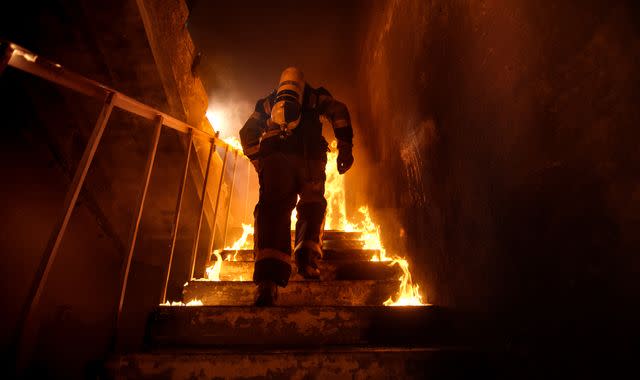Firefighters more likely to die from cancer than general public, study finds

Firefighters are more likely to die from cancer, heart attacks and strokes than the general population, a new study has found, prompting calls for action.
Research carried out by the University of Central Lancashire found that firefighters north of the border had a mortality rate for all cancers 1.6 times higher than other people.
It also revealed firefighters are dying from heart attacks at five times the rate of the general public and almost at three times the rate from a stroke.
Riccardo la Torre, Fire Brigades Union national officer, said the findings "should horrify the fire services and the government".
"This is about firefighters dying who did not need to. We cannot lose any more firefighters unnecessarily," he said.
"Lives are being lost amongst our friends and colleagues and it must stop. We need to catch problems early and mitigate problems early."
He called for "health surveillance" and "monitoring of exposures".
"We need legislation that will ensure that affected firefighters are given the compensation they deserve," he said.
"At the moment we are sorely lacking in all of these areas. It is high time that ends."
Researchers looked at mortality data from the National Records of Scotland - which found the number of firefighters who have died from prostate cancer was 3.8 times higher than the general population, 3.2 times higher for leukaemia, and 2.4 times higher for oesophageal cancer.
In instances where cancer with an unknown origin has spread, the rate was 6.4 times higher than the general population.
Led by Professor Anna Stec, the research team examined records of firefighters between 30 and 74 years of age, of which there were 672.
The study, which looked at mortality figures between 2000 and 2020, has now been published in the Journal of Occupational Medicine.
Ms Stec, professor in fire chemistry and toxicity at the university, said: "It's important that firefighters can continue to do their jobs as safely as possible, and the research shows that measures such as health monitoring and reducing exposure from contaminants at the workplace will play an important part in protecting firefighters."
Read more
London Fire Brigade put into special measures after probe
Fire service warns against 'risk to life' TikTok heating 'hack'
Excess cancer mortality was likely linked to different kinds of exposures and fire toxins, according to the report.
This could be triggered by ingestion - for example, when firefighters swallow mucus in which fire effluent has become trapped, or of they have eaten food with contaminated hands.
Research suggested mortality rates from leukaemia are linked to exposure to other chemicals such as benzene from contact with skin or inhalation.
There has been a downtrend in the number of cancer deaths across the general population due to lifesaving measures and effective treatment - but researchers found the opposite trend among firefighters.
Firefighters appeared to have higher cancer rates at younger ages, they said, and were often too young to be offered cancer screening on the NHS which mainly targeted older age groups.
Scottish Fire and Rescue Service Assistant Chief Officer Andy Watt said the safety of staff is "paramount" and that they are aware of "this important piece of research and will now review the findings".
"The service has already undertaken work to minimise the risk of contaminants for our staff. This includes a substantial review of how fire appliances, personnel and PPE are decontaminated during and following an incident," he said.


